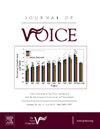直接幅度估计(DME)在听觉知觉评估中测量语音障碍严重程度的有用性
IF 2.5
4区 医学
Q1 AUDIOLOGY & SPEECH-LANGUAGE PATHOLOGY
引用次数: 0
摘要
本文章由计算机程序翻译,如有差异,请以英文原文为准。
Usefulness of Direct Magnitude Estimation (DME) in Auditory Perceptual Assessments Measuring Dysphonia Severity
Objectives
The purposes of this study were (1) to analyze the reliability of direct magnitude estimation (DME) scales in auditory perceptual assessments measuring dysphonia severity and (2) to analyze the usefulness of DME scales in comparison to that of equal-appearing interval (EAI) scales.
Study Design
Three speech language pathologists perceptually evaluated dysphonia severity from connected speech samples produced by 105 participants with dysphonia. Two auditory perceptual assessments using two scales (DME and EAI) were performed for 2 weeks. The reliabilities of auditory perceptual assessments were analyzed, and correlation analysis was performed to analyze the relationship between the two scales.
Results
DME and EAI were found to have high reliability for auditory perceptual assessments measuring voice severity. There was a significant curvilinear relationship between EAI and DME. This indicates that a prosthetic continuum represents the dysphonia severity and suggests that DME scales should be used to measure dysphonia severity to avoid the linear partitioning related to EAI scales.
Conclusions
Our study supports the use of DME scales when judging the overall voice severity of dysphonic patients.
求助全文
通过发布文献求助,成功后即可免费获取论文全文。
去求助
来源期刊

Journal of Voice
医学-耳鼻喉科学
CiteScore
4.00
自引率
13.60%
发文量
395
审稿时长
59 days
期刊介绍:
The Journal of Voice is widely regarded as the world''s premiere journal for voice medicine and research. This peer-reviewed publication is listed in Index Medicus and is indexed by the Institute for Scientific Information. The journal contains articles written by experts throughout the world on all topics in voice sciences, voice medicine and surgery, and speech-language pathologists'' management of voice-related problems. The journal includes clinical articles, clinical research, and laboratory research. Members of the Foundation receive the journal as a benefit of membership.
 求助内容:
求助内容: 应助结果提醒方式:
应助结果提醒方式:


